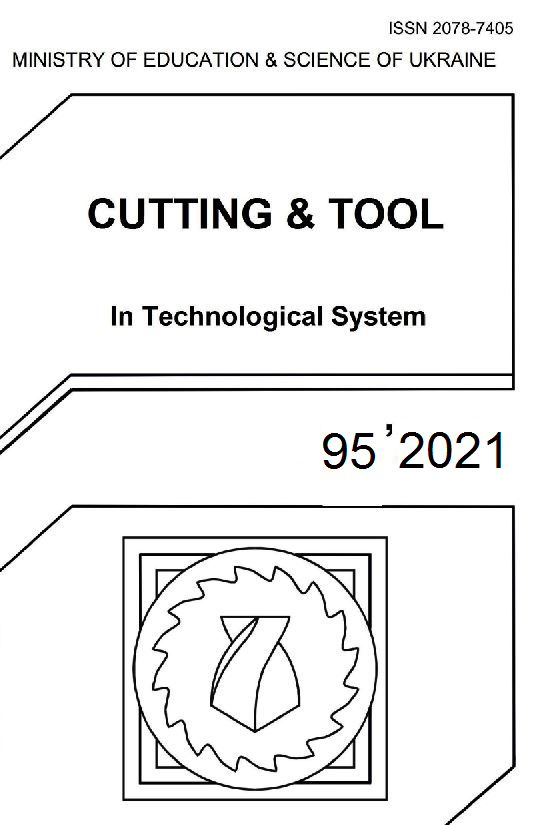RESULTS OF INDUSTRIAL TESTING OF CARBIDE CUTTING TOOLS BY PULSED MAGNETIC FIELD TREATMENT AND THE EFFECT ON THE INCREASE OF THE CUTTING PROCESS EFFICIENCY
DOI:
https://doi.org/10.20998/2078-7405.2021.95.01Abstract
The task of increasing the efficiency of machining parts on heavy machines was determined, scientifically substantiated and solved by hardening a carbide tool the pulsed magnetic field processing (PMFP). The efficiency of machining of parts is understood as an increase in its productivity, a reduction in the cost and costs of tool materials, and an increase in instrument reliability. The working conditions of cutting tools at heavy engineering enterprises are analyzed. The wear resistance of carbide cutting tools, which have been strengthened by the PMFP, was investigated using forced test methods and modeling of the cutting process. The mechanism of changing the properties of a hard alloy under the action of a pulsed magnetic field is established. The main factors affecting the change in the wear resistance of a hard alloy under the action of a pulsed magnetic field are identified. The effect of pulsed magnetic field processing on the performance of carbide cutting tools under production conditions is investigated. The effect of hardening on productivity, cost of operation and instrumental costs is established. The interrelation of the parameters of the PMFP, the parameters of the process of machining parts and production efficiency is investigated. A statistical model has been developed that allows determining the productivity of mechanical processing depending on the properties of the tool material and the processing parameters of a pulsed magnetic field.
References
Quan S. Effect of pulsed magnetic field treatment on the residual stress of 20Cr2Ni4A steel / Quan S., Jiajie K., Zhiguo X., Haidou W., Yanfei H., Guozheng M., Haipeng L. // Journal of Magnetism and Magnetic Materials. – 15, April 2019. Volume 476. – рр. 218-224. https://doi.org/10.1016/j.jmmm.2018.12.105.
Huang Xinquan C. Residual stress reduction by combined treatment of pulsed magnetic field and pulsed current / Huang Xinquan C. // Materials Science and Engineering:A., 25 July 2011. – Volume 528. – Issues 19-20/ – pp. 6287-6292. https://doi.org/10.1016/j.msea.2011.04.078.
Ma L. An investigation on the mechanical property changing mechanism of high speed steel by pulsed magnetic treatment / Ma L., Zhao W., Liang Z., Wang X., Xie L., Jiao L., Zhou T. // Materials Science and Engineering: A., 15 July 2014, – Volume 609. – pp. 16–25. https://doi.org/10.1016/j.msea.2014.04.100.
Shapovalov M. Kovalov V., Vasylchenko Y. Increase the productivity of hard-alloy tools for heavy machine tools by processing impulse magnetic field Вісник ТНТУ. Тернопіль, 2018. № 3 (50). С. 52–59.
Kovalov V., Vasilchenko Y., Shapovalov M, Turmanidze R., Dašić P. Impact of a Pulsed Magnetic Field on a Hard Alloy During Machining on Heavy Machine Tools. International Journal of Industrial Engineering and Management (IJIEM), Vol. 10 No 1, 2019, Pp. 125–130. ISSN 2217-2661. https://doi.org/10.24867/IJIEM-2019-1-125.
Rodichev Y., Soroka O., Kovalov V., Vasilchenko Y., Maiboroda V. (2020) Fracture Resistance of the Edge of Cemented Carbide Cutting Tool. In: Tonkonogyi V. et al. (eds) Advanced Manufacturing Processes. InterPartner 2019. Lecture Notes in Mechanical Engineering. Springer, Cham. https://doi.org/10.1007/978-3-030-40724-7_29.
Downloads
Published
Issue
Section
License
Copyright Notice
Authors who publish with this Collection agree to the following terms:
1. Authors retain copyright and grant the Collection right of first publication with the work simultaneously licensed under a Creative Commons Attribution License that allows others to share the work with an acknowledgement of the work's authorship and initial publication in this Collection.
2. Authors are able to enter into separate, additional contractual arrangements for the non-exclusive distribution of the Collection's published version of the work (e.g., post it to an institutional repository or publish it in a book), with an acknowledgement of its initial publication in this Collection.
3. Authors are permitted and encouraged to post their work online (e.g., in institutional repositories or on their website) prior to and during the submission process, as it can lead to productive exchanges, as well as earlier and greater citation of published work.

